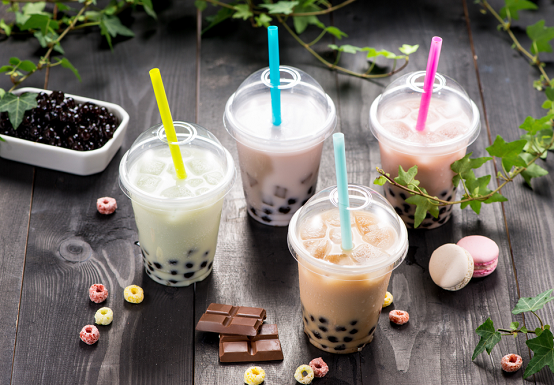
Bubble tea is a wildly popular drink in Singapore and its variety seems to have exploded over recent years. With the basic brew consisting of tea, milk, creamer, sugar and tapioca pearls, bubble tea is ubiquitous on our sunny
island but what is its nutritional value and how much of it should we be drinking?
Tea is good for you – but not everything that’s added to it
Drinking green tea and black tea has been associated with reduced risk of cardiovascular disease, diabetes, arthritis and even cancer. This is due to their polyphenols which have anti-inflammatory and antioxidant properties.
However, when ingredients like non-dairy creamer and toppings are added in, the increase in fat and sugar content instead increases the risk of chronic diseases. For instance, non-dairy creamer contains trans fat in the form of hydrogenated palm oil which has been strongly correlated with increasing the risk of heart disease and stroke.
Another thing to consider is the amount of sugar present in a cup of bubble tea. A medium-sized 500ml bubble milk tea with pearls and the full amount of sugar has 8 teaspoons of sugar and 335 calories. The larger 700ml size has 11 teaspoons of sugar and 469 calories. The growing popularity of newer varieties such as honey pearls or brown sugar syrup would mean exceeding HPB’s recommendation of 8-11 teaspoons of sugar per day for adults – all in a single drink! Kids and teenagers should be having even less, with HPB recommending less than 5 teaspoons of sugar each day.
Ultimately, bubble tea is still considered a sugar-sweetened beverage – placing it among the likes of soft drinks, energy drinks and 3-in-1 instant coffees and teas.
| Milk Tea with Pearls | Brown Sugar Milk Tea with Pearls | Mango Green Tea | Passionfruit Green Tea | Winter Melon Tea | Jasmine Green Tea with Fruits | Avocado Tea with Pearls |
|---|---|---|---|---|---|---|
| 8 teaspoons of sugar | 18.5 teaspoons of sugar | 8 teaspoons of sugar | 8.5 teaspoons of sugar | 16 teaspoons of sugar | 8.5 teaspoons of sugar | 7.5 teaspoons of sugar |
*Take note that jellies and pearls are kept in a sweet syrup before serving to keep them moist, thus adding to the
sugar content of your drink
What are some healthier options for toppings?
Not all toppings are equal in their amount of energy. Choose a lower calorie option if you want to go for toppings,for instance aloe vera, herbal jelly or white pearls instead of the classic black tapioca pearls – or skip the toppings altogether.
| Tapioca Pearls | 156 | White Pearls | 42 |
|---|---|---|---|
| Coconut Jelly | 76 | Ai Yu Jelly | 45 |
| Herbal Jelly | 57 | Pudding Jelly | 89 |
| Aloe Vera | 31 | Rainbow Jelly | 71 |
| Red Bean | 40 | Oreo | 1160at |
| Cereal | 54 | Milk Foam | 203 |
| Cheese Foam | 160 to 200 |
*Take note that jellies and pearls are kept in a sweet syrup before serving to keep them moist, thus adding to the
sugar content of your drink
Can I make drinking bubble tea a guilt free experience?
Do bear in mind that the calories in 1 medium cup of bubble tea rival that of a slice of cheesecake, so limiting your intake is important if you are watching your weight. Here are some tips to improve the nutritional content of your bubble tea!
Some bubble tea shops don’t allow customers to choose the sweetness level or change the toppings, so choose a place which allows you to make these healthier choices.
REFERENCES
Sweeter than soda? The hidden sugars in bubble tea. CNA. Mediacorp Pte Ltd. Retrieved from < https://www.channelnewsasia.com/news/singapore/bubble-tea-sugar-content-sweeter-than-coke-soda-11063316>
Accessed 26 June 2019.
Cheong T. & Wong H.X. (2019) Bubble Tea: Healthy or Not? Healthxchange.sg
(Singhealth, Singapore General Hospital. Retrieved from < https://www.healthxchange.sg/food-nutrition/food-tips/bubble-tea-healthy-or-not>
Accessed 26 June 2019.
K N. (2018) How Many Calories Are in Tapioca Bubble Tea? Livestrong.com Retrieved from
< https://www.healthxchange.sg/food-nutrition/food-tips/bubble-tea-healthy-or-not>
Accessed 26 June 2019.
Krisnan R. (2017) Gong Cha Spills Their Calorie Counts On The Menu For Less Sinful Life Decisions. The Smart Local.
Retrieved from < https://thesmartlocal.com/read/gongcha-calories>
Accessed 26 June 2019.
Min J.E., Green D.B. & Kim L. (2016) Calories and sugars in boba milk tea: implications for obesity risk in Asian
Pacific Islanders. Food science & Nutrition. 2017 Jan; 5(1): 38–45.
Vos M.B., Kaar J.L., Welsh J.A., Van Horn L.V., Feig D.I., Anderson C.A.M., Patel M.J., Munos J.C., Krebs N.F.,
Xanthakos S.A. & Johnson R.K. (2017) Added Sugars and Cardiovascular Disease Risk in Children: A Scientific
Statement From the American Heart Association. Circulation. 2017;135:e1017–e1034.
Health Promotion Board – Energy and Nutrient Composition of Food
This article is contributed by our dietitians from the Nutrition and Dietitian department of Mount Alvernia Hospital. To learn more about our Nutrition and Dietitian services, click here